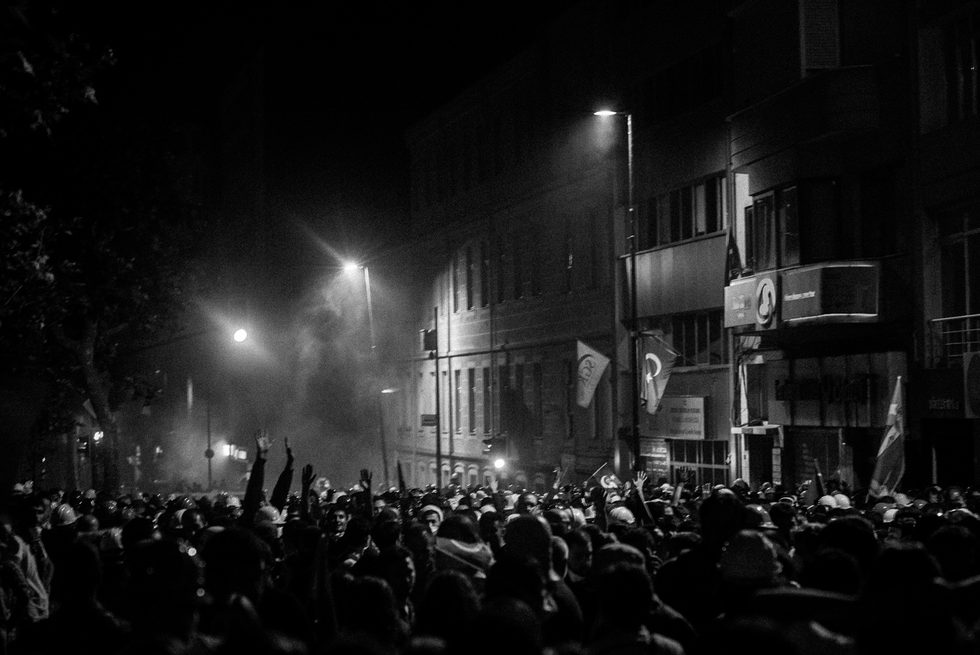Improbable Encounters: Marching for Lice in Kadıköy
From the Series: An Impromptu Uprising: Ethnographic Reflections on the Gezi Park Protests in Turkey
From the Series: An Impromptu Uprising: Ethnographic Reflections on the Gezi Park Protests in Turkey

On the evening of June 28, 2013, a group of several-thousand people marched through the streets of Kadıköy, a neighborhood on the Asian side of Istanbul that is known to be mostly inhabited by middle-class, “white Turkish” residents.1 Probably for the first time, Kurdish slogans resounded through the neighborhood’s narrow streets: thousands were shouting, “Long live the brotherhood of peoples!” (Bijî biratiya gelan in Kurdish)—even if not always sure about the correct pronunciation, let alone the meaning of these foreign-sounding words—alongside Turkish slogans like “Resist Lice, Kadıköy is with you!” (Diren Lice, Kadıköy seninle in Turkish).2 Granted, in the excitement of the moment, Lice occasionally came across some lips as Dicle (both Kurdish and Turkish for the river Tigris); yet the slippage fortuitously remained within the imaginary geography of Kurdistan and, in any case, was hardly discernable for Kadıköy’s ears, largely unfamiliar as they were with Kurdish. After the march, at the Kadıköy’s people’s assembly, the unusual juxtaposition of languages, symbols, and slogans continued to astonish observers as elderly women passionately waved Turkish flags in support of speeches delivered in Kurdish, calling forth enthusiastic tweets, such as “If somebody who is holding the Turkish flag in their hands is shouting ‘Murderous state’ [Katil devlet in Turkish], nothing is ever going to be the same again.”
What had happened that was able to bring about these startling manifestations? In the afternoon of the same day, in the Kurdish town of Lice, Kurdish eighteen-year-old Medeni Yıldırım had been shot dead by Turkish soldiers during a protest against the extension of a military station. The killing was taken up by the protest movement in Istanbul, Ankara, Izmir, and other Western Turkish cities that very night. Police violence in Gezi, military violence in Lice; Ethem Sarısülük in Ankara,3 Medeni Yıldırım in Lice; calls for democracy in Taksim, calls for peace in Kurdistan—these connections were quickly forged by the Gezi protesters. Yet in many ways, these connections did not fully connect. They were attempts at reaching out that did not always encounter the response that some might have hoped for: at the same time as Kurdish slogans resounded through Kadıköy’s streets, the streets of most Kurdish towns remained silent. While Lice had suddenly made its appearance in the imagined geographies of Kadıköy’s residents in Istanbul, Kadıköy remained a blank spot for many in Kurdistan.
The fact that Kadiköy’s Lice march—and the Gezi protests more broadly (see Bozcalı & Yoltar)—were met largely with indifference in Kurdistan might be reason to dampen the much-rehearsed enthusiasm about the Gezi protests as having brought about a new coalition between Turkish secular–liberal forces and the Kurdish movement. But if not the transformation of well-established political alliances, what might provide (at least) equal reason for enthusiasm is focusing our attention on how the Lice protests were transformative of Kadıköy’s “white Turks.” Recognizing that political activism is productive of particular subjectivities on the part of those participating as much as it is an activity that is oriented towards an exterior, the fact that the gesture towards Lice did not find an immediate response becomes perhaps less significant than what the protest meant for the transformation of “selves” in Kadıköy: lips that articulated the unfamiliar sounds of Kurdish, minds that sought to map the town of Lice, sensibilities that experienced anger at the death of a Kurdish youth. Rather than the enthusiastic “nothing is ever going to be the same again,” we might then state that “Kadıköy is never going to be the same again,” in order to capture the space of self-transformation that opened up during the night of June 28.
At the same time, it remains crucial that the protesters in Kadıköy were genuinely seeking to reach out to the Kurdish residents of Lice. Effectively, they were thus taking a step towards what Judith Butler (2004, xviii) has described as “admit[ting] the ‘faces’ of those against whom war is waged into public representation.” With this in mind, the echoing of Medeni Yıldırım’s name through the streets of Kadıköy may in itself be considered significant, even though Lice and Kadıköy perhaps, in the end, did not connect. Significant, because it constituted an attempt—even if only provisional and momentary—to include the death of a Kurdish youth within the sphere of those whose death is considered publicly grievable (cf. Athanasiou 2005; Butler 2004) and of those whose death incites anger and calls for action.
1. “White Turks” (Beyaz Türkler) is a widely used expression in Turkey to denote the Kemalist, secular, well-educated and urban Turkish middle- and upper-classes. For the historical relation between Kemalist “white Turks” and Turkey’s Kurdish population, see Zeydanlıoğlu (2008).
2. Lice is a Kurdish-inhabited town in the district of Diyarbakır.
3. Ethem Sarısülük was shot by a policeman on June 1, 2013, during the Gezi-related protests in Ankara. He passed away on June 14 after two weeks in intensive care.
Athena Athanasiou, “Reflections on the Politics of Mourning: Feminist Ethics and Politics in the Age of Empire.” Historein 5 (2005): 40–57.
Judith Butler, Precarious Life: The Powers of Mourning and Violence, London: Verso, 2004.
Welat Zeydanlıoğlu, “’The White Turkish Man’s Burden’: Orientalism, Kemalism and the Kurds in Turkey.” In Neo-colonial Mentalities in Contemporary Europe? Language and Discourse in the Construction of Identities, edited by Guido Rings, and Anne Ife, 155–74, Newcastle upon Tyne: Cambridge Scholars Publishing, 2008.